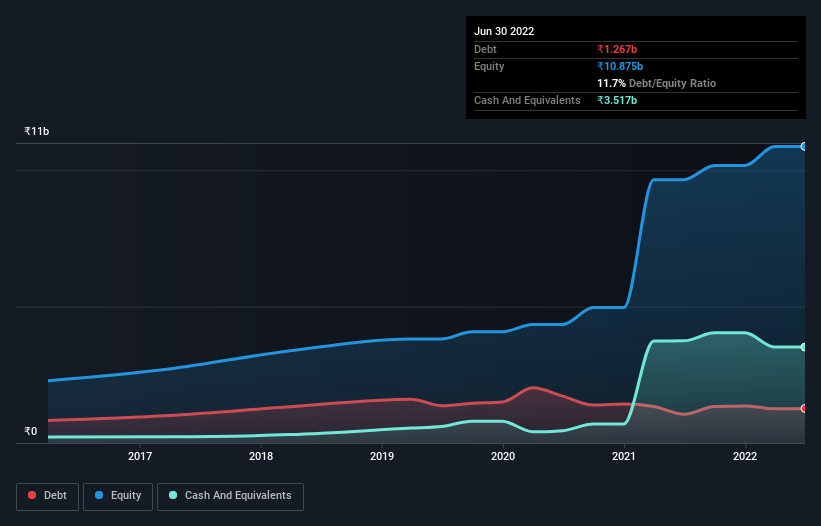- India
- /
- Medical Equipment
- /
- NSEI:POLYMED
We Think Poly Medicure (NSE:POLYMED) Can Stay On Top Of Its Debt

Warren Buffett famously said, 'Volatility is far from synonymous with risk.' When we think about how risky a company is, we always like to look at its use of debt, since debt overload can lead to ruin. As with many other companies Poly Medicure Limited (NSE:POLYMED) makes use of debt. But should shareholders be worried about its use of debt?
When Is Debt A Problem?
Debt and other liabilities become risky for a business when it cannot easily fulfill those obligations, either with free cash flow or by raising capital at an attractive price. Part and parcel of capitalism is the process of 'creative destruction' where failed businesses are mercilessly liquidated by their bankers. However, a more common (but still painful) scenario is that it has to raise new equity capital at a low price, thus permanently diluting shareholders. Of course, plenty of companies use debt to fund growth, without any negative consequences. The first step when considering a company's debt levels is to consider its cash and debt together.
Check out our latest analysis for Poly Medicure
How Much Debt Does Poly Medicure Carry?
You can click the graphic below for the historical numbers, but it shows that as of March 2022 Poly Medicure had ₹1.27b of debt, an increase on ₹1.05b, over one year. But it also has ₹3.52b in cash to offset that, meaning it has ₹2.25b net cash.

How Healthy Is Poly Medicure's Balance Sheet?
The latest balance sheet data shows that Poly Medicure had liabilities of ₹2.27b due within a year, and liabilities of ₹626.8m falling due after that. On the other hand, it had cash of ₹3.52b and ₹2.24b worth of receivables due within a year. So it actually has ₹2.86b more liquid assets than total liabilities.
This short term liquidity is a sign that Poly Medicure could probably pay off its debt with ease, as its balance sheet is far from stretched. Succinctly put, Poly Medicure boasts net cash, so it's fair to say it does not have a heavy debt load!
On the other hand, Poly Medicure's EBIT dived 14%, over the last year. If that rate of decline in earnings continues, the company could find itself in a tight spot. There's no doubt that we learn most about debt from the balance sheet. But it is future earnings, more than anything, that will determine Poly Medicure's ability to maintain a healthy balance sheet going forward. So if you're focused on the future you can check out this free report showing analyst profit forecasts.
But our final consideration is also important, because a company cannot pay debt with paper profits; it needs cold hard cash. Poly Medicure may have net cash on the balance sheet, but it is still interesting to look at how well the business converts its earnings before interest and tax (EBIT) to free cash flow, because that will influence both its need for, and its capacity to manage debt. Considering the last three years, Poly Medicure actually recorded a cash outflow, overall. Debt is far more risky for companies with unreliable free cash flow, so shareholders should be hoping that the past expenditure will produce free cash flow in the future.
Summing Up
While we empathize with investors who find debt concerning, you should keep in mind that Poly Medicure has net cash of ₹2.25b, as well as more liquid assets than liabilities. So we are not troubled with Poly Medicure's debt use. We'd be motivated to research the stock further if we found out that Poly Medicure insiders have bought shares recently. If you would too, then you're in luck, since today we're sharing our list of reported insider transactions for free.
At the end of the day, it's often better to focus on companies that are free from net debt. You can access our special list of such companies (all with a track record of profit growth). It's free.
New: Manage All Your Stock Portfolios in One Place
We've created the ultimate portfolio companion for stock investors, and it's free.
• Connect an unlimited number of Portfolios and see your total in one currency
• Be alerted to new Warning Signs or Risks via email or mobile
• Track the Fair Value of your stocks
Have feedback on this article? Concerned about the content? Get in touch with us directly. Alternatively, email editorial-team (at) simplywallst.com.
This article by Simply Wall St is general in nature. We provide commentary based on historical data and analyst forecasts only using an unbiased methodology and our articles are not intended to be financial advice. It does not constitute a recommendation to buy or sell any stock, and does not take account of your objectives, or your financial situation. We aim to bring you long-term focused analysis driven by fundamental data. Note that our analysis may not factor in the latest price-sensitive company announcements or qualitative material. Simply Wall St has no position in any stocks mentioned.
About NSEI:POLYMED
Poly Medicure
Manufactures and sells medical devices in India and internationally.
Flawless balance sheet with high growth potential.
Market Insights
Community Narratives



